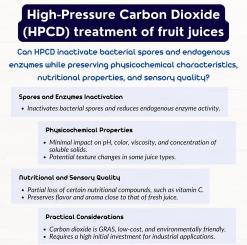高压二氧化碳(HPCD):对果汁质量的影响以及孢子和酶的灭活
IF 7
1区 农林科学
Q1 FOOD SCIENCE & TECHNOLOGY
引用次数: 0
摘要
在保持果汁营养和感官品质的同时,确保其微生物安全仍然是食品加工中的一项重大挑战。传统的热处理方法虽然能有效抑制植物病原体,但会降低重要营养成分的含量,而且对细菌孢子的灭活效果较差。高压二氧化碳(HPCD)技术利用高压下的二氧化碳灭活孢子和酶,是一种很有前途的非热敏替代方法。更重要的是,高压二氧化碳灭菌技术在保存果汁质量方面显示出巨大的潜力。本综述评估了近期有关在果汁中使用 HPCD 的研究,重点关注其在减少孢子数量和灭活多酚氧化酶 (PPO) 和果胶甲基酯酶 (PME) 等酶方面的效果。此外,还研究了 HPCD 对果汁的理化、营养和感官属性(如维生素保留率、颜色和浑浊度)的影响。尽管 HPCD 具有诸多优势,但在优化工艺参数以实现一致的微生物灭活方面仍面临挑战,不同的工艺参数会因果汁成分和微生物菌株而异。此外,虽然初始成本较高,但由于能耗较低和二氧化碳可回收利用,HPCD 的长期经济可行性是有利的。未来的研究应侧重于优化设备设计和扩大 HPCD 技术的工业应用规模。本文章由计算机程序翻译,如有差异,请以英文原文为准。

High-pressure carbon dioxide (HPCD): Impact on the quality of fruit juices and inactivation of spores and enzymes
Ensuring microbiological safety in fruit juices while maintaining their nutritional and sensory qualities remains a significant challenge in food processing. Traditional thermal methods, although effective against vegetative pathogens, can degrade important nutrients and are less effective at inactivating bacterial spores. High-pressure carbon dioxide (HPCD) technology has emerged as a promising non-thermal alternative, using CO2 under high pressure to inactivate spores and enzymes. More importantly, HPCD has shown great potential in preserving the quality of fruit juices. This review assesses recent studies on the use of HPCD in fruit juices, focusing on its effectiveness in reducing spore counts and inactivating enzymes like polyphenol oxidase (PPO) and pectin methylesterase (PME). The impact of HPCD on the physicochemical, nutritional, and sensory attributes of fruit juices, such as vitamin retention, color, and cloudiness, is also examined. Despite HPCD’s advantages, challenges remain in optimizing process parameters for consistent microbial inactivation, with variations depending on juice composition and microbial strain. Additionally, while initial costs are high, the long-term economic viability of HPCD is favorable due to lower energy consumption and CO2 recyclability. Future research should focus on optimizing equipment design and scaling HPCD technology for industrial applications.
求助全文
通过发布文献求助,成功后即可免费获取论文全文。
去求助
来源期刊

Food Research International
工程技术-食品科技
CiteScore
12.50
自引率
7.40%
发文量
1183
审稿时长
79 days
期刊介绍:
Food Research International serves as a rapid dissemination platform for significant and impactful research in food science, technology, engineering, and nutrition. The journal focuses on publishing novel, high-quality, and high-impact review papers, original research papers, and letters to the editors across various disciplines in the science and technology of food. Additionally, it follows a policy of publishing special issues on topical and emergent subjects in food research or related areas. Selected, peer-reviewed papers from scientific meetings, workshops, and conferences on the science, technology, and engineering of foods are also featured in special issues.
 求助内容:
求助内容: 应助结果提醒方式:
应助结果提醒方式:


